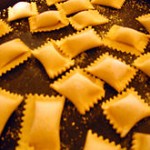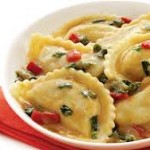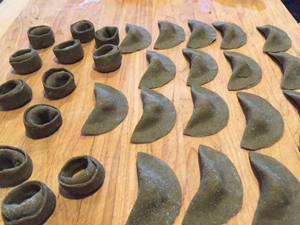
There is another name for stuffed pasta found on menus just about everywhere in Italy but apparently nowhere in the U.S. except maybe in the high end restaurants. The name is Agnolotti and you don’t ever pronounce the “g”.
These tasty items are normally stuffed with ground up braised veal or pork and parmesan cheese. According to the scholars the more familiar Ravioli usually, but not always, are stuffed with other cheeses such as ricotta and vegetables such as spinach, in addition to or instead of ground meat. So you ask, all in all what is the difference?
Answer, none if the stuffing is the only criterion. Nonetheless the two versions at one time in history sported some differences. Agnolotti are regarded as having originated in the Piedmont region and traditionally looked like folded rectangles starting out as a single sheet of pasta dough. Ravioli normally involve two sheets pressed together with filling in between and then crimp cut into squares or circles.
Over time this distinction in nomenclature has virtually disappeared.
Today all you need to distinguish the two is an obsession for solid geometry as well as stuffed pasta. I know several people with those very characteristics currently undergoing corrective treatment.

Preparing the alleged original version of agnolotti is not as easy as serving up the more familiar square or disc shaped ravioli. Home made ravioli can be turned out by the hundreds in inexpensive pasta machines with a ravioli attachment. Agnolotti, or any folded stuffed and crimped pasta, are strictly “hands on” for the home chef.
To complicate matters sometimes both varieties show up in the form of half moon semicircles (mezzaluna in Italian).
Serving up a batch of hand made half-circle stuffed pasta for the dinner guests is proof of a chef’s deliberate attempt to impress the crowd. The only prerequisite is extra time. Hope for a rainy Saturday and organize your plan of attack. If possible recruit a neighbor’s Italian grandma whose dexterity is undiminished over the years and rivals the most efficient industrial pasta machinery.

In all my vast lifelong exposure to Italian family cooking I have never witnessed the forebears making agnolotti or ravioli by by any manner except with the crimping cutter or the aluminum press. I have the crimping roller plus a round cutter and two of the pre-formed aluminum ravioli stamps. I have yet to gain respect for the clumsy mass producing ravioli maker that comes as an attachment to the hand crank machine or the KitchenAid mixer.
To complete the picture we must draw brief attention to the dozens of other stuffed pasta variations such as anellini, cannelloni, capellacci, capelletti, casoncelli, tortelli, tortellini, and assorted others, all based on the same fresh pasta recipes and essentially hundreds of fully interchangeable recipes for filling.
Having thus duly scratched the surface of a topic that fills volumes of sleep-inducing Italian literature let us now consider a real life example of an agnolotti/ravioli exercise recently performed here in the kitchen. Be prepared for a major time-consuming ordeal. There are no short cuts unless you can rent all the Italian grandmas in the neighborhood for a few hours.
Agnolotti Piemontesi and/or Ravioli “Mezzaluna”
For this production I followed a typical agnolotti recipe from the Italian websites. However because I intended to match the pasta up with a bolognese meat sauce for a dinner party I shortened the filling ingredients by eliminating ground veal or pork, which already form part of the bolognese.
Also in a gesture of recognition toward the non-Northern Italians I added a measure of ricotta cheese thus yielding a dish that can truly be called by either name. I did not include spinach because I used a pasta sheet recipe that calls for whole wheat flour mixed with eggs and pureed spinach, i.e. pasta verde. Are we clear?
This recipe for half-moon agnolotti serves 12 or more people.
For the Pasta Verde sheets:
- 5 cups whole wheat flour
- 4 eggs plus water if needed
- 1 cup finely pureed spinach
For the filling:
- 4 ounces mortadella with pistachio
- 4 ounces prosciutto ham
- 4 ounces spicy soppressata (you can cheat with peperone, if so use less)
- 1/2 cup ricotta cheese drained of most liquid
- 1/2 cup imported parmesan cheese (not the stuff in the green can)
- 1 large egg
- 1/2 teaspoon nutmeg
- 2 tbsp. chopped fresh Italian parsley
- salt & pepper to taste
Preparation: Stage One. Start by making the pasta sheets. Mix the flour, eggs and spinach in a large bowl or by the notorious “well method” which involves making a huge unnecessary mess on the table like you see on TV. The mixture should be somewhat stiff but if too stiff add water in small amounts at a time. Once all the flour is incorporated and everything forms up nicely into a smooth ball transfer to a floured pastry board and knead until kingdom come. No less than 10 minutes anyway. Coat with a teaspoon of olive oil, wrap in plastic and let stand in the refrigerator for 30 minutes. You can skip the gym.
Stage Two. Meanwhile make the filling. Gather up the mortadella, prosciutto and soppressata and feed them through your handy dandy meat grinder, one of the many optional and occasionally useful attachments available for your KitchenAid. Run the meat through a second time and make sure the mixture is uniform throughout. Add the ricotta, egg, parmesan, parsley, nutmeg, salt and pepper. Mix thoroughly. This mixture should also be fairly stiff in texture. Cover with plastic and set aside.
Stage Three. Now for the hard part. Remove the pasta dough from the refrigerator and set in a separate nearby location covered with plastic wrap. Lock in your hand crank pasta machine. Set up your pastry board dusted with flour. Cut off a fist-sized chunk of dough, flatten it with a rolling pin and begin rolling it through the machine settings starting with number 1. After rolling once fold the sheet in half lengthwise and put it through the same setting a second time.
Do this for the first three settings, flouring the sheet lightly each time to prevent sticking. On my machine the process is over once I reach setting 6. The numbering may be different on yours, but you definitely do not want sheets that are so thin they will break apart as soon as you try to fill them. One sixteenth of an inch is ideal, which you verify by grabbing the micrometer from the toolbox in the garage and checking the thickness. Lightly flour the finished sheets rubbing gently with your hand. Lay them aside on a cloth surface and cover with kitchen towels. You don’t want them to dry out.
 Stage Four. By now you should have five or six rolled out pasta sheets of varying lengths. At this point all you need to do is to cut round discs out with a 2 and 3/4 inch diameter cookie cutter, looking to make around twelve discs at a time. Lay the discs on the pastry board in two rows.
Stage Four. By now you should have five or six rolled out pasta sheets of varying lengths. At this point all you need to do is to cut round discs out with a 2 and 3/4 inch diameter cookie cutter, looking to make around twelve discs at a time. Lay the discs on the pastry board in two rows.
Bring out the filling. With a teaspoon scoop up a marble-size portion of filling and lay it on the center of each disc. Wet the edges of each disc with your finger dipped in water. Fold the disc in half and press down firmly around the edges. Congratulations, you just made your first agnolotto.
Stage Five. Once you have created 50 or so half-moon agnolotti you wait for the guests to arrive. Secretly you hope for no-shows so you can have leftover agnolotti all to yourself. As soon as people show up move to the stovetop and boil up 5 quarts of salted water. Working with 20 pieces at a time cook the agnolotti for about 6 or 7 minutes. The longer cooking time is attributable to the whole wheat pasta, which takes slightly longer to cook up.
Drain and serve with authentic bolognese sauce, sprinkle with parmesan cheese (not the stuff in the green can), and if you don’t think you’ve achieved culinary Nirvana you weren’t paying attention.
Irrelevant Post Script: In the photo above you might notice not only the half-moon agnolotti on the right but also rolled up items made from the exact same ingredients and the very same stuffed discs. This is intended to confuse the reader. The items on the left, because of the geometric characteristics, are officially considered tortelli. Tortelli are a somewhat larger version of the ubiquitous tortellini. The point is we can no longer call them agnolotti because, why? The shape is different. Amen
